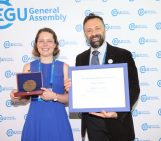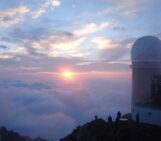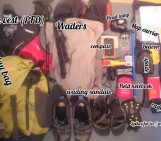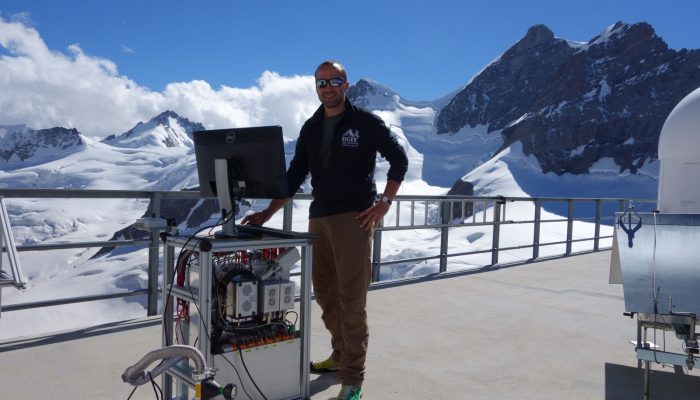
Geotalk is a regular feature highlighting early career researchers and their work. In this interview we speak to Federico Bianchi, a researcher based at University of Helsinki, working on understanding how clouds are born. Federico’s quest to find out has taken him from laboratory experiments at CERN, through to the high peaks of the Alps and to the clean air of the Himalayan mountains. His innovative experimental approach and impressive publication record, only three years out of his PhD, have been recognised with one of four Arne Richter Awards for Outstanding Early Career Scientists in 2017.
First, could you introduce yourself and tell us a little more about your career path so far?
I am an enthusiastic atmospheric chemist with a passion for the mountains. My father introduced me to chemistry and my mother comes from the Alps. This mix is probably the reason why I ended up doing research at high altitude.
I studied chemistry at the University of Milan where I got my degree in 2009. During my bachelor and master thesis I investigated atmospheric issues affecting the polluted Po’ Valley in Northern Italy and since then I have always worked as an atmospheric chemist.
I did my PhD at the Paul Scherrer Institute in Switzerland where I mainly worked at the CLOUD experiment at CERN. After that, I used the acquired knowledge to study the same phenomena, first, at almost 4000 m in the heart of the Alps and later at the Everest Base Camp.
I did one year postdoc at the ETH in Zurich and now I have my own Fellowship paid by the Swiss National Science Foundation to conduct research at high altitude with the support of the University of Helsinki.
We are all intimately familiar with clouds. They come in all shapes and sizes and are bringers of shade, precipitation, and sometimes even extreme weather. But most of us are unlikely to have given much thought to how clouds are born. So, how does it actually happen?
We all know that the air is full of water vapor, however, this doesn’t mean that we have clouds all the time.
When air rises in the atmosphere it cools down and after reaching a certain humidity it will start to condense and form a cloud droplet. In order to form such a droplet the water vapor needs to condense on a cloud seed that is commonly known as a cloud condensation nuclei. Pure water droplets would require conditions that are not present in our atmosphere. Therefore, it is a good assumption to say that each cloud droplet contains a little seed.
At the upcoming General Assembly you’ll be giving a presentation highlighting your work on understanding how clouds form in the free troposphere. What is the free troposphere and how is your research different from other studies which also aim to understand how clouds form?
The troposphere, the lower part of the atmosphere, is subdivided in two different regions. The first is in contact with the Earth’s surface and is most affected by human activity. This one is called the planetary boundary layer, while the upper part is the so called free troposphere.
From several studies we know that a big fraction of the cloud seeds formed in the free troposphere are produced by a gas-to-particles conversion (homogeneous nucleation), where different molecules of unknown substances get together to form tiny particles. When the conditions are favourable they can grow into bigger sizes and potentially become cloud condensation nuclei.
In our research, we are the first ones to take state of the art instrumentation, that previously, had only been used in laboratory experiments or within the planetary boundary layer, to remote sites at high altitude.
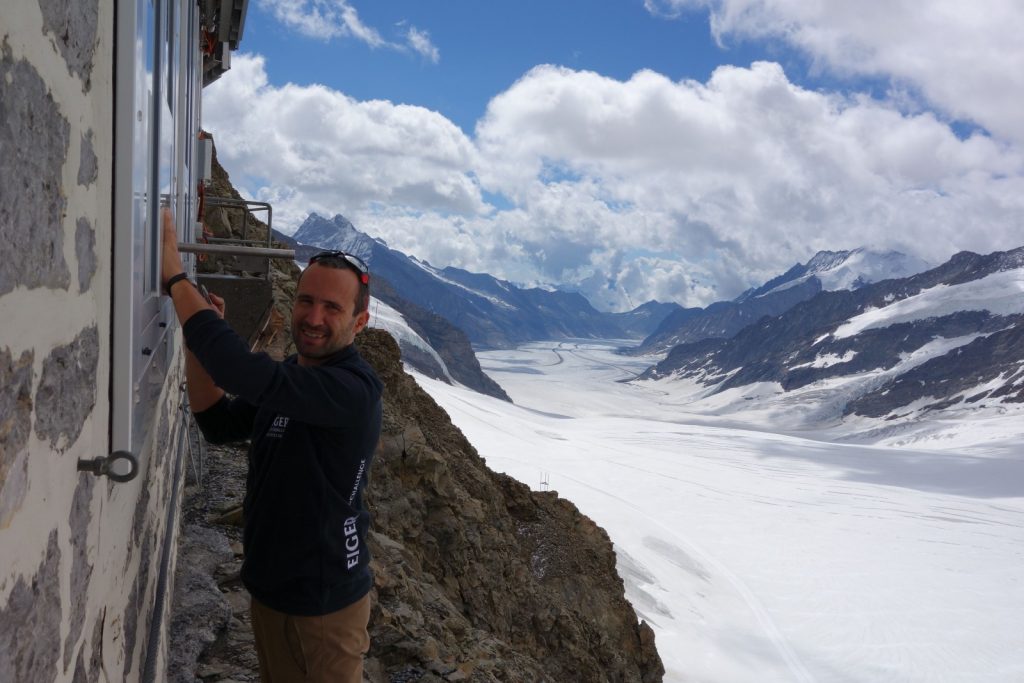
Federico has taken state of the art instrumentation, that previously, had only been used in laboratory experiments or within the planetary boundary layer, to remote sites at high altitude. Credit: Federico Bianchi
At the General Assembly you plan on talking about how some of the processes you’ve identified in your research are potentially very interesting in order to understand the aerosol conditions in the pre-industrial era (a time period for when information is very scarce). Could you tell us a little more about that?
Aerosols are defined as solid or liquid particles suspended in a gas. They are very important because they can have an influence on the Earth’s climate, mainly by interacting with the solar radiation and cooling temperatures.
The human influence on the global warming estimated by the Intergovernmental Panel for Climate Change (known as the IPCC) is calculated based on a difference between the pre-industrial era climate indicators and the present day conditions. While we are starting to understand the aerosols present currently, in the atmosphere, we still know very little about the conditions before the industrial revolution.
For many years it has been thought that the atmosphere is able to produce new particles/aerosol only if sulphur dioxide (SO2) is present. This molecule is a vapor mainly emitted by combustion processes; which, prior to the industrial revolution was only present in the atmosphere at low concentrations.
For the first time, results from our CLOUD experiments, published last year, proved that organic vapours emitted by trees, such as alpha-pinene, can also nucleate and form new particles, without the presence of SO2. In a parallel study, we also observed that pure organic nucleation can take place in the free troposphere.
We therefore have evidence that the presence of sulphur dioxide isn’t necessary to make such a mechanism possible. Finally, with all this new information, we are able to say that indeed, in the pre-industrial era the atmosphere was able to produce new particles (clouds seeds) by oxidation of vapors emitted by the vegetation.
Often, field work can be a very rewarding part of the research process, but traditional research papers have little room for relaying those experiences. What were the highlights of your time in the Himalayas and how does the experience compare to your time spent carrying out laboratory experiments?
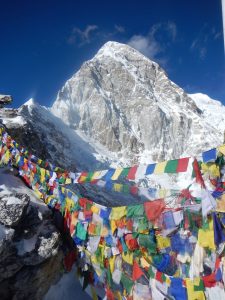
Doing experiments in the heart of the Himalayas is rewarding. But life at such altitude is tough. Breathing, walking and thinking is made difficult by the lack of oxygen at high altitudes.
I have always been a scientists who enjoys spending time in the laboratory. For this reason I very much liked the time I spent in CERN, although, sometimes it was quite stressful. Being part of such a large international collaboration and being able to actively do science was a major achievement for me. However, when I realized I could also do what I love in the mountains, I just couldn’t stop myself from giving it a go.
The first experiment in the Alps was the appetizer for the amazing Himalayan experience. During this trip, we first travelled to Kathmandu, in Nepal. Then, we flew to Luckla (hailed as one of the scariest airport in the world) and we started our hiking experience, walking from Luckla (2800 m) up to the Everest Base Camp (5300 m). We reached the measurement site after a 6 days hike through Tibetan bridges, beautiful sherpa villages, freezing nights and sweaty days. For the whole time we were surrounded by the most beautiful mountains I have ever seen. The cultural element was even more interesting. Meeting new people from a totally different culture was the cherry on the cake.
However I have to admit that it was not always as easy as it sounds now. Life at such altitude is tough. It is difficult to breath, difficult to walk and to install the heavy instrumentation. In addition to that, the temperature in your room during nights goes well below zero degrees. The low oxygen doesn’t really help your thinking, especially we you need to troubleshoot your instrumentation. It happens often that after such journey, the instruments are not functioning properly.
I can say that, as a mountain and science lover, this was just amazing. Going on a field campaign is definitely the best part of this beautiful job.
To finish the interview I wanted to talk about your career. Your undergraduate degree was in chemistry. Many early career scientists are faced with the option (or need) to change discipline at sometime throughout their studies or early stages of their career. How did you find the transition and what advice would you have for other considering the same?
As I said before, I studied chemistry and by the end of my degree my favourite subject moved to atmospheric chemistry. The atmosphere is a very complex system and in order to study it, we need a multidisciplinary approach. This forced me to learn several other aspects that I had never been in touch with before. Nowadays, I still define myself as a chemist, although my knowledge base is very varied.
I believe that for a young scientist it is very important to understand which are his or her strengths and being able to take advantage of them. For example, in my case, I have used my knowledge in chemistry and mass spectrometry to try to understand the complex atmospheric system.
Geotalk is a regular feature highlighting early career researchers and their work.

